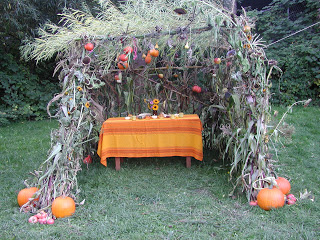This week, my children’s third grade Waldorf class celebrated the Jewish harvest festival of Sukkot. To honor of the 40-year period the people of Israel spent wandering through the desert and living in temporary shelters, it is customary to build and dwell in a temporary shelter called a Sukkah. We gathered bamboo at a local farm and then fashioned a Sukkah frame. Then the children and members of the school community brought in gleanings from their gardens and farms. I cut down all of our corn stalks that we had harvested from, big bunches of sunflowers and dill, and colorful little gourds. The class had great fun fastening corn stalks and flowers all around, and hanging gourds and apples by the stem with twine to dangle down from the roof. It was beautiful and tapped into the impulse in all of us, both young and old, to build forts.
In the spirit of dwelling in the Sukkah, the teacher invited us to have a dinner potluck and camp out at school in tents around our wonderful structure. We gathered together and shared a delicious meal, sang songs and did traditional Jewish folk dances, and sat around the campfire for some of the teacher’s wonderful storytelling. She told a tale of two brothers, one wealthy and one poor, who built their Sukkah structures for Sukkot. The wealthy brother built a beautiful and elaborate Sukkah, with the finest fruits and served the finest meal, but didn’t truly welcome strangers in as he should in the spirit of the festival. The poor brother built the best Sukkah he could with the bruised and overripe fruits he was able to acquire from the market, and in this Sukkah, everyone was welcome. One Sukkat, three heavenly beings came to visit each of the brothers, and magically transformed their Sukkahs to reflect on the outside what was on the inside. The wealthy brother’s structure became rotten and full of bugs, while the poor brother’s structure turned into fruits of silver and gold. From then on, he prospered, and his wealthy brother learned to welcome and include everyone, sharing what he had. It was told much more eloquently by the teacher, of course, but I wanted to relay the basic message. After that, my son volunteered to tell a story from ancient India he learned of a Brahmin and a Tiger. He told it so willingly to the whole group of us, and so well, with such detail, that I was in awe. It was one of those moments where your child brings forth a new, shining skill you had no idea they possessed. I was a very proud mamma.
We all settled into our tents and slept out in the lower field of our school, under the stars on the hot September night. Our children’s teacher, in keeping with the Sukkat tradition, slept under the Sukkah we had built. Then they all rolled out of their tents in the morning, put on school clothes, had hot rice cereal for breakfast, and went about their school day. What a fun memory they will always have of the night they camped out at their school! I am constantly grateful to have such a wonderful school and teacher in our lives.
If you want to know more about Sukkot, I found this information page on a Judaism 101 website, compiled by Tracey Rich from her years of research: http://www.jewfaq.org/holiday5.htm#Sukkah.

I LOVE building forts!
Love the structure you all built and the story you shared. Good message to remember.
And I Love the part about River's storytelling spirit coming out to shine! 🙂